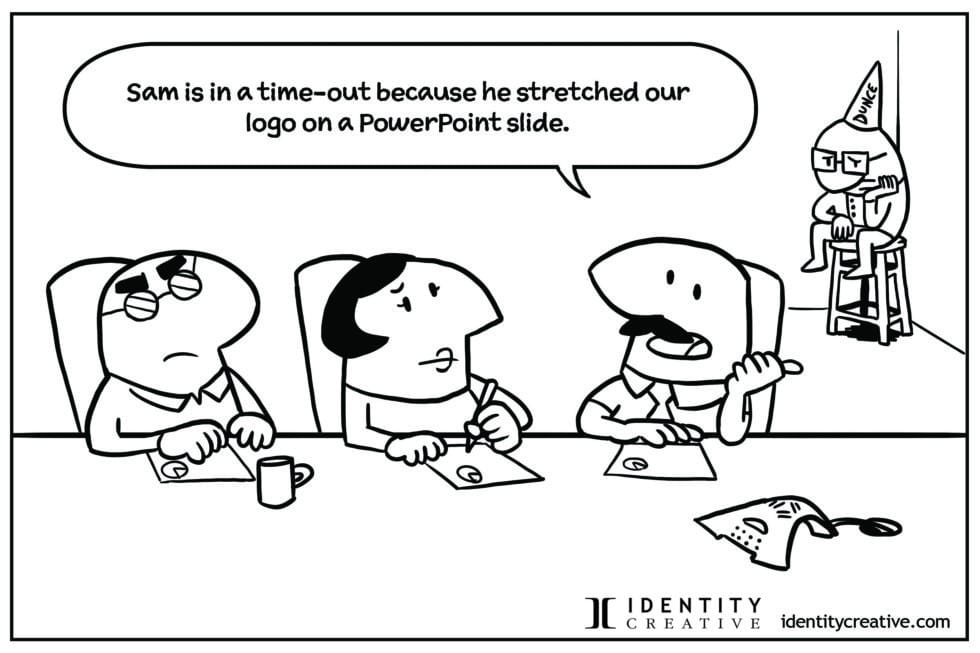Marketing directors often struggle to convince a business owner that the company’s logo has become a detriment. It’s because many owners have the misconception that the design of their logo is irrelevant when it comes to actual business performance, like increased sales. They assume brand design doesn’t impact purchasing decisions.
That assumption is easily contradicted by studies that demonstrate brand design influences people’s purchasing decisions.
“Branding has become one of the most important determinants of consumer choices.” – From a study by Marios G. Philiastides and Roger Ratcliff, published in Association for Psychological Science.
When business leaders don’t see a direct correlation between investing time and money to rebrand and sales, it can be a tough call for them to make. Unlike digital marketing and its clearly measurable and readily available analytics, we need to look in different places to see the corresponding relationship between brand design’s impact on attracting customers and closing sales.
Does brand design significantly impact the potential for business growth?
Can a logo improve memorability and influence purchasing decisions? There is a world of evidence that backs up this view.
Here are three proven factors that brand design can impact purchasing:
1. Perception is Reality.
Seeing is believing. A well-executed logo and supporting brand design exude credibility and create a positive impression.
When people positively perceive a brand, they are more likely to associate it with superior products or services. A positive perception paves the way to an affirmative purchasing decision.
It’s human nature to ‘judge a book by its cover.’
Exquisite brand design can convey that the business is competent, trustworthy, and fully capable of meeting customers’ needs and expectations. Poorly executed or implemented design can do the opposite. Ouch.
“I know it’s the exact same product. I know it costs a little bit more to buy from CompanyX. But their website, logo, and everything about their design is stunning.
It just looks like they care more and will have better customer service. “
A business owner told me this story when we discussed updating her company’s logo. She had been shopping online and was embarrassed to reveal that she paid a higher price for the same product. She had not recognized her subliminal thought process until we discussed the impact of brand design on purchasing decisions.
Even Shape Matters
There are universal qualities of design that the human psyche interprets with impressive continuity.
For example, Psychological Science cited five experiments by Jiang, Gorn, Galli, & Chattopadhyay. They “document that the mere circularity and angularity of a brand logo is powerful enough to affect perceptions of the attributes of a product or company.”
In one of their experiments, college students were shown athletic shoe advertisements with one of two logos: a circular or an angular. Participants gave the shoes with the circular logo a higher rating for likely comfort.
The Subliminal Drive
A professionally created brand possesses multiple characteristics and creates an impression of higher value for the products or services it represents. See The Power of Pricing in Your Brand Strategy. When a brand is associated with quality, customers are willing to pay a premium for its products or services. This perceived value will lead to higher profit margins and increased sales revenues.
If you’ve ever purchased an Apple product, for instance, and held the box in your hand, then you know what it’s like to be seduced by the soft-touch packaging, slick graphics, and feeling of quality before even opening the box. They made a strategic impression, and the perceived value of what you purchased is validated in your mind.
Customers are more likely to choose a brand they perceive as positive and can relate to, even if it comes with a slightly higher price tag. If it’s effectively branded, they will trust that they are getting a superior product or service over your competitors.
If expert design helps strengthen your brand image, the converse is true: poor design will bruise the brand you’re working to build. Where is your company on the scale of quality design? This is a pivotal determination every business must make.
2. Consistency Builds Credibility.
Over-choice is a challenge for today’s marketers. People have a plethora of choices when it comes to purchasing your product. When your brand stands out as a credible choice, it reduces risk and stress in the buyer’s decision-making process.
Consistent and cohesive branding components include logo orientations, color, typography, and brand messaging across all marketing materials, online and offline.
Branding that builds trust wins.
In a recent post, INVESP pulled statistics together by researchers on how branding influences purchasing decisions. No surprise that trust ranks highest in a buyer’s purchasing decision.
These brand qualities were ranked in order of preference among buyers:
1. Trust
2. Creativeness
3. Intelligence
4. Authenticity
5. Confidence
For years we’ve echoed Mary Neumeier, a master in the branding world, “Trust is the greatest shortcut to a buying decision and the bedrock of modern branding.”
Interestingly, 64% of respondents also said they would open an email simply because they trusted the brand.
What does consistency in design and implementation have to do with credibility?
You’ll never see the Amazon logo stretched or rotated. Ford Motor Company wouldn’t alter its logo for a short-term campaign. Global brands understand the strength of their trademark. It’s like a nation’s flag. Don’t mess with it.
Consistency is critical, and there is a reason for it. Wise brand managers know they must maintain consistent design, style, and implementation with strict adherence. Everywhere a logo is placed, from a stadium to a social post, building brand recognition must include a commitment to following the Brand’s Style Guide or Brand Standards Guide.
In fun, we call the rules outlined in a Brand Standards Guide “Logo Laws.“ Every business needs a Chief Brand Officer (CBO) who assists everyone in the company to faithfully follow the brand’s design and messaging standards.
Consistency in brand design is what people will see before they give you a call or walk through your office. It’s what they’ll unconsciously notice in your sales and marketing collateral. It will give a credible impression and pave the way to establishing greater trust with your consumers.
3. Your Brand is Your Flag.
Brands that don’t stand out, or stand for anything, are drowned out in a sea of competitive industries.
“If you don’t differentiate your goods or services, don’t expect your business to be around for very long.” – Jim Collins
Your logo can be like your nation’s flag.
An iconic and unique logo propels a business to stand out from competitors. A distinctive brand will be a key differentiating factor in a crowded marketplace, where people have more choices than ever.
A nation’s flag is enduring. A well-designed, clean, and uncomplicated logo, yet unique and intriguing, has the potential to grow into something iconic. Without question, the rest of the brand experience has to keep its promise to every customer to be sustainable.
Your brand can stand for something.
One of the conclusions in the article “A Study on the Impact of Brand Logos on Consumer Buying Behaviour,” published in the International Journal of Engineering, Science, and Computing, supports this idea:
“Brands should enhance the logo visibility so that people are not clueless about what the logo means and they don’t have a second thought as to whether they should purchase the product.”
The study focused on how a brand’s logo influences consumer behavior. The study examined how an individual or group selects, purchases, uses, or disposes of a brand’s services or products. It also measured how they were attracted to a brand to satisfy their needs and desires.
The researchers defined a “brand logo” as a “name, term, sign, symbol or design or combination of them, intended to identify the goods and service of one seller or group of sellers and to differentiate them from those of competitors.”
Leverage the Power of a well-crafted brand.
A well-defined brand identity with a strategic brand position in the marketplace will set a business apart, be remembered, and be perceived as credible.
Employee pride in the look and feel of their company’s brand also plays a lead role in their perceptions. “Dress for Success” was popularized in the 1970s, and while dress codes have changed, the sense that dressing professionally hasn’t. The logos people wear make them feel like they’re a part of something to which they want to belong.
Leveling the path to your door—whether it’s attracting talent or more customers—can be done with exceptional attention to brand design. When people have the ideal perception of your brand, it will give you the competitive advantage that drives growth.






